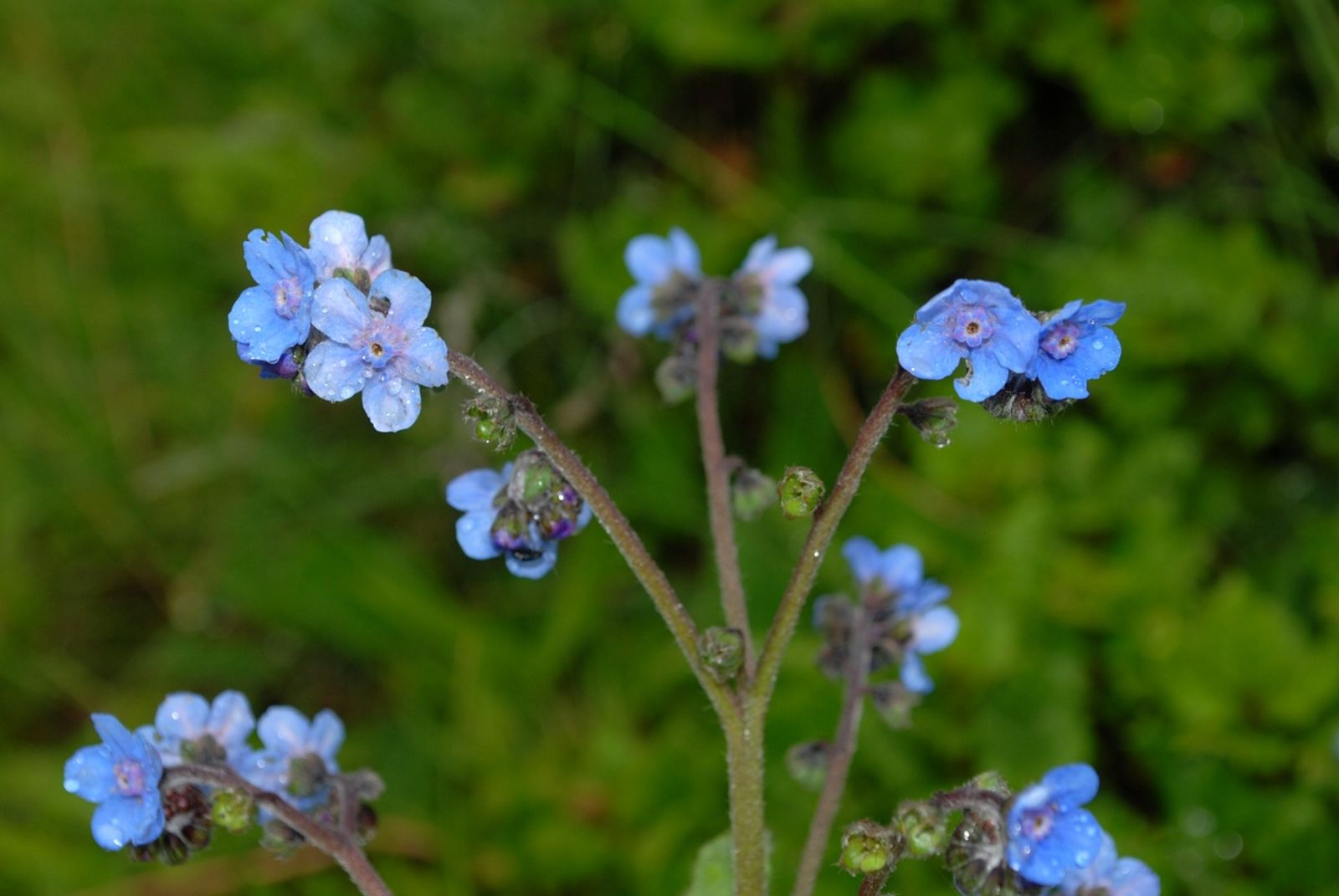Family: Boraginaceae
Author: Stapf & J.R.Drumm.
Bibliography: Bull. Misc. Inform. Kew 1906: 202 (1906)
Year: 1906
Status: accepted
Rank: species
Genus: Cynoglossum
Vegetable: False
Observations: C. Nepal to C. China and Thailand
Description
Chinese hound’s tongue, scientifically known as Cynoglossum amabile, is a cherished plant within the Boraginaceae family. This species was formally described in the Bulletin of Miscellaneous Information from Kew in 1906 by botanists Stapf and J.R. Drumm.
Originating from a diverse geographical range, Cynoglossum amabile is native to central Nepal, extends across central China, and even reaches the landscapes of Thailand. This adaptability to various environments highlights its resilience and versatility.
Chinese hound’s tongue is renowned for its beautiful, vibrant blue flowers, which have made it a popular choice among gardeners and plant enthusiasts. Its blossoms not only add picturesque charm to gardens but also attract pollinators, such as bees and butterflies, contributing to the ecological health of its surrounding environment.
In addition to its aesthetic appeal, Cynoglossum amabile is often featured in traditional medicine within its native regions. The plant is valued for its potential medicinal properties, though it should be noted that proper identification and knowledge are necessary for any medicinal use.
As a member of the Boraginaceae family, Cynoglossum amabile shares many characteristics with its relatives, including a typical hairy texture on its leaves and stems, which is a distinguishable trait within this family.
Whether grown in a home garden for its ornamental beauty or studied for its ecological and medicinal potential, Chinese hound’s tongue remains a fascinating and valuable plant species with much to offer both botanically and culturally.
Common Names
Eng: chinese hound’s tongue, chinese hound’s-tongue, chinese hound’s-toungue, chinese-forget-me-not
Deu: chinesische hundszunge, chinesisches vergissmeinnicht, liebliche hundszunge, chinesische hundszunge
Dan: kinesisk hundetunge
Swe: kinesisk förgätmigej
Spa: ninfle
En: Chinese hound’s tongue, Chinese hound’s-tongue, Chinese hound’s-toungue, Chinese-forget-me-not, Chinese forget-me-not
Da: Kinesisk hundetunge
De: Chinesische Hundszunge, Chinesisches Vergissmeinnicht, Liebliche Hundszunge, Chinesische Hundszunge
Es: Ninfle
Sv: Kinesisk förgätmigej
Synonyms
Distribution
- China North-Central (native)
- China South-Central (native)
- East Himalaya (native)
- Nepal (native)
- Thailand (native)
- Tibet (native)
- Argentina Northeast (introduced)
- Argentina Northwest (introduced)
- Arkansas (introduced)
- Austria (introduced)
- Bolivia (introduced)
- Brazil South (introduced)
- Colombia (introduced)
- Costa Rica (introduced)
- Dominican Republic (introduced)
- Ecuador (introduced)
- El Salvador (introduced)
- Fiji (introduced)
- Great Britain (introduced)
- Guatemala (introduced)
- Haiti (introduced)
- Hawaii (introduced)
- Honduras (introduced)
- Ireland (introduced)
- Jamaica (introduced)
- Japan (introduced)
- Jawa (introduced)
- Kenya (introduced)
- Kermadec Is. (introduced)
- KwaZulu-Natal (introduced)
- Masachusettes (introduced)
- Mexico Southwest (introduced)
- New Hampshire (introduced)
- New York (introduced)
- New Zealand North (introduced)
- New Zealand South (introduced)
- Oklahoma (introduced)
- Panamá (introduced)
- Peru (introduced)
- Puerto Rico (introduced)
- Tanzania (introduced)
- Tristan da Cunha (introduced)
- Venezuela (introduced)
- Wisconsin (introduced)
Additional Images
Habit
Taken Dec 29, 2021 by Trap Hers (cc-by-sa)
Taken Aug 26, 2018 by Hugo SANTACREU (cc-by-sa)
Taken Oct 13, 2021 by SpontanVegetation (cc-by-sa)
Taken Sep 15, 2011 by Photoflora – Jean-Luc TASSET (©)
Taken Oct 28, 2022 by Else Nolden (cc-by-sa)
Flower
Taken Oct 28, 2022 by Else Nolden (cc-by-sa)
Taken Sep 25, 2021 by Martin W (cc-by-sa)
Taken May 6, 2020 by Lopes Ricardo (cc-by-sa)
Taken Aug 31, 2021 by Cor Clo (cc-by-sa)
Taken Apr 3, 2020 by lee william (cc-by-sa)

© copyright of the Board of Trustees of the Royal Botanic Gardens, Kew.

© copyright of the Board of Trustees of the Royal Botanic Gardens, Kew.

© copyright of the Board of Trustees of the Royal Botanic Gardens, Kew.
Leaf
Taken Aug 23, 2021 by High Treeson (cc-by-sa)
Taken Aug 26, 2018 by Hugo SANTACREU (cc-by-sa)
Taken Aug 26, 2018 by Hugo SANTACREU (cc-by-sa)
Taken Dec 29, 2021 by Trap Hers (cc-by-sa)
Taken Jul 16, 2022 by Astrid Ehrgott (cc-by-sa)
Fruit
Taken Sep 15, 2011 by Photoflora – Jean-Luc TASSET (©)
Taken Aug 25, 2021 by Else Nolden (cc-by-sa)
Taken Aug 26, 2018 by Hugo SANTACREU (cc-by-sa)
Taken Aug 26, 2018 by Hugo SANTACREU (cc-by-sa)
Taken Aug 26, 2018 by Hugo SANTACREU (cc-by-sa)
Bark
Taken May 6, 2022 by Álvaro Del Risco (cc-by-sa)
Taken Aug 26, 2018 by Hugo SANTACREU (cc-by-sa)
Other
Taken Jul 6, 2020 by Gerda Teunissen (cc-by-sa)
Taken Sep 13, 2022 by FrankReynolds (cc-by-sa)
Taken Sep 15, 2008 by Photoflora – Jean-Luc TASSET (©)
Sources
- WFO (No URL)
- IPNI (No URL)
- GBIF (https://www.gbif.org/species/2925816)
- POWO (http://powo.science.kew.org/taxon/urn:lsid:ipni.org:names:115031-1)
- PlantNet (https://identify.plantnet.org/species/the-plant-list/Cynoglossum amabile Stapf & J.R.Drumm.)
Specifications
Growth habit>: Forb/herb

























